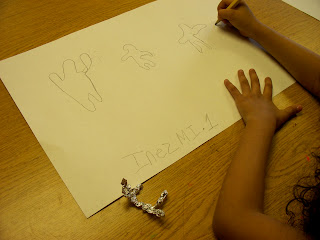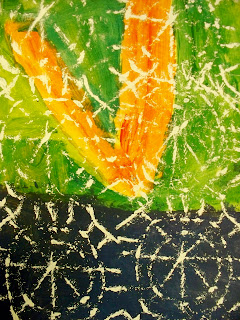









5th grade students made these striking neutral collages of cityscapes as their first art project of the year. I found it was a great way to begin the year in art, because it wasn't as intimidating as drawing is to some students, and each student could be successful with this project. We first looked at a PPT presentation I created on "The City in Art". We discussed paintings of the city by various artists, what a skyline is, what makes a skyline interesting to look at besides the sheer size of the skyscrapers (the variety in the skylines' rooftops, sizes of the buildings- some tall, some shorter, the colors of the buildings), and we looked at our own Houston skyline. I asked the students what they noticed about our citys' skyline on their trips into the city with their families, what their favorite building was and why, how tall they thought the skyscrapers were and how many windows they had, and what happens in the everyday hustle and bustle of the city (transportation, people moving from here to there, where are they going, what are they doing).
Last, I showed them a photo taken of three buildings with different styles of architecture in Houston; the photo was of one building in front of the other, the shortest one in front, then the medium sized one in the middle and the tallest at the back. It showed how the buildings overlap one another. It also showed three distinct styles of architecture in our citys' history; one from the 1970's, one from the 1980's and one from the 1990's.
Before teaching this project, I tore the cardboard layer off of sheets of cardboard scraps to reveal the corrugation. I cut them into various sizes of rectangles. I cut newspaper clippings into various sizes of rectangles, as well, being careful to weed out any inappropriate ads or pictures or text. I also cut black, gray, and brown papers for buildings. Included in our supplies were; glue, black sharpie markers, white prismacolor pencils, and scissors.
I handed the students a brown piece of paper as their background, a gray piece of paper to tear for their road, and piled a variety of materials for their buildings in the center of their tables. They were free to choose the papers in the sizes and colors they wanted. I instructed the students to make interesting rooflines, overlap buildings, fill their papers up with them and most of all, make sure there was a lot of variety in their building sizes and rooflines. I demonstrated different ways they could cut or add to their papers to create them, and told them not to be concerned with the finer details of their buildings in the beginning, that would come last. Right now they were "building" their citys.
Once the students had glued the buildings to their papers, it was time to add those details; windows, street scenes, billboards and signs, newspaper clouds in the sky, were some of the suggestions. As usual, they totally blew me away with their creativity and imaginations! This project allowed them the freedom to express their own ideas of the city and what they know and feel about it. The wheels were spinning in their heads as they were deciding on what papers to use, what buildings they could have in their artwork, how they were going to make all the windows on their skyscrapers and what types of details they wanted to add. I reminded them about the scale in their project; making sure they didn't make their doors or windows too large, or a sign or a person the size of a skyscraper, that they would be tiny in comparison.
They all loved working on this project. Not a student in the class didn't know what they wanted to do. It was great to witness them so engaged and working with their hands and their minds to problem solve and make choices and decisions. They also found it interesting to work with the cardboard and the newspaper, commenting they didn't know they could make art with those materials. The recyclable aspect of the project was appealing to everyone.
This project took about three art classes to complete. When they were done, we had cityscapes galore and an entire school ooohing and ahhhhing over them. They were amazed at how creative the students were and how beautiful their art was. Since the project was such a hit, I decided to expand on this architecture theme in art and have them create 3D buildings using paper folded into right angles to make the structures of the buildings... more on this project to come. We had to put it on hold, since I teach 9 weeks at a time at each of my two campuses. It was time for me to go to my other campus, so we put away our buildings until I return... that's life in the big city!















































